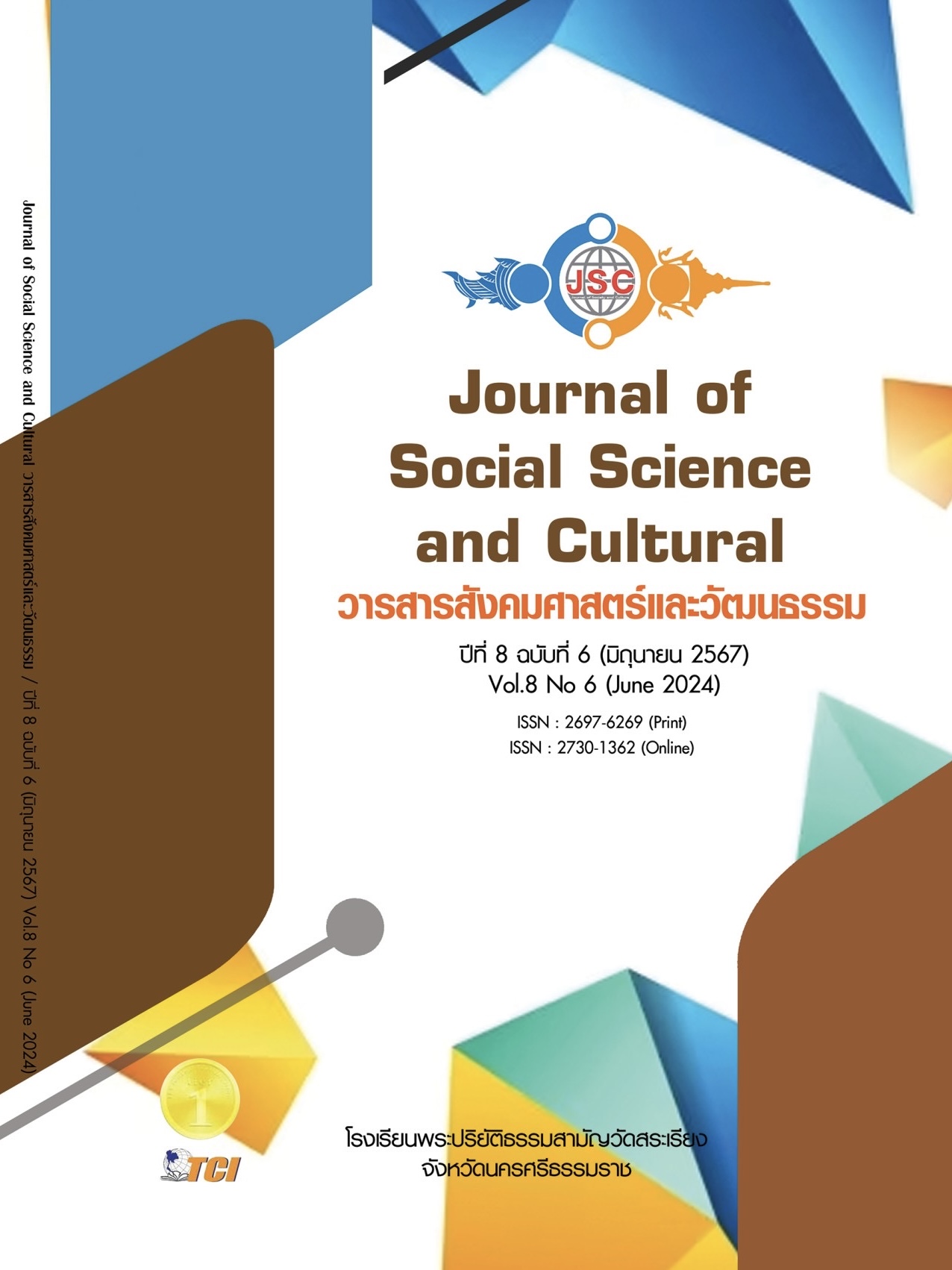การพัฒนารูปแบบการจัดการตนเองที่มีต่อความสำเร็จ ในการจัดการป่าชุมชนอย่างยั่งยืน
Main Article Content
บทคัดย่อ
การวิจัยครั้งนี้มีวัตถุประสงค์เพื่อ 1) ศึกษาสภาพการณ์การจัดการทรัพยากรป่าชุมชนอย่างยั่งยืน
2) ศึกษาวิธีการปฏิบัติที่ดีที่มีต่อความสำเร็จในการจัดการป่าชุมชนอย่างยั่งยืน และ 3) พัฒนารูปแบบการจัดการตนเองที่มีต่อความสำเร็จในการจัดการป่าชุมชนอย่างยั่งยืน เป็นการศึกษาวิธีวิจัยแบบผสมผสาน โดยเชิงปริมาณ ใช้เครื่องมือเป็นแบบประเมินตนเองในการจัดการทรัพยากรป่าไม้โดยชุมชน กลุ่มตัวอย่าง ได้แก่ สมาชิกในชุมชนที่มีการจัดการทรัพยากรป่าไม้ในเขตพื้นที่ป่าสาธารณะประโยชน์ พื้นที่ป่าสงวนแห่งชาติ พื้นที่อนุรักษ์และได้รับรางวัลลูกโลกสีเขียว จำนวน 14 ชุมชน วิเคราะห์สถิติด้วยค่าเฉลี่ย และส่วนเบี่ยงเบนมาตรฐาน โดยเลือกแบบเจาะจง และเชิงคุณภาพ ใช้เครื่องมือเป็นแบบสัมภาษณ์เชิงลึกและสนทนากลุ่ม ผู้ให้ข้อมูลสำคัญ ได้แก่ กลุ่มผู้นำชุมชน ผู้อาวุโส ปราชญ์ชาวบ้าน หน่วยงานท้องถิ่น คณะกรรมการป่าชุมชน ผู้ใช้ประโยชน์จากป่า กลุ่มเยาวชน จำนวน 15 คนต่อชุมชน ผลการวิจัยพบว่า 1) ชุมชนส่วนใหญ่มีการจัดการทรัพยากรป่าไม้อยู่ในระดับดีมาก โดยให้ความสำคัญกับการจัดการขอบเขตทรัพยากรป่าไม้เป็นลำดับแรก รองลงมาเป็นการจัดการสุขภาวะป่าไม้ การเข้าถึงทรัพยากรและการแบ่งปันผลประโยชน์ และความมั่นคงทางอาหาร ตามลำดับ 2) วิธีการปฏิบัติที่ดีที่มีต่อความสำเร็จในการจัดการป่าชุมชนอย่างยั่งยืน ประกอบด้วย การมีส่วนร่วมของผู้มีส่วนเกี่ยวข้อง การแลกเปลี่ยนข้อมูลร่วมกัน การกระจายอำนาจการจัดการ และ 3) รูปแบบการจัดการป่าชุมชนอย่างยั่งยืน ดำเนินการใน 4 ขั้นตอน คือ การติดตามตรวจสอบสภาพการณ์จัดการ การทบทวนสะท้อนผล การวางแผนกิจกรรม และการพัฒนาปรับปรุงแก้ไข โดยกระบวนการดังกล่าวจะต้องมีความหลากหลายของกลุ่มผู้มีส่วนได้ส่วนเสียในการเข้ามามีส่วนร่วมในทุกขั้นตอน
Article Details
เอกสารอ้างอิง
กองนโยบายและแผนสำนักงานอธิการบดี มหาวิทยาลัยราชภัฏจันทรเกษม. (2564). คู่มือเทคนิคการกำหนดตัวชี้วัด. กรุงเทพมหานคร: มหาวิทยาลัยราชภัฏจันทรเกษม.
กาญจนา แก้วเทพ. (2565). การเสริมพลังกับงานวิจัยเพื่อท้องถิ่น. เชียงใหม่: มูลนิธิสถาบันวิจัยเพื่อท้องถิ่น.
ธนัญภรณ์ แพรสะอาด. (2558). การจัดการทรัพยากรป่าไม้บริเวณพื้นที่ต้นน้ำของชุมชนบ้านขอบด้ง อำเภอฝาง จังหวัดเชียงใหม่. ใน วิทยานิพนธ์ศิลปศาสตรมหาบัณฑิต สาขาวิชาการจัดการมนุษย์กับสิ่งแวดล้อม. มหาวิทยาลัยเชียงใหม่.
นรินทร์ เอื้อศิริวรรณ และคณะ. (2560). การกำหนดหลักเกณฑ์คัดเลือกตำแหน่งที่เหมาะสมสำหรับการจัดตั้งสถานีตรวจสอบน้ำหนักโดยการใช้ทฤษฎีกระบวนการลำดับชั้นเชิงวิเคราะห์ (AHP). วารสารวิศวกรรมสารเกษมบัณฑิต, 7(1), 17-33.
นิตยา โพธิ์นอก และรัชวดี แสงมหะหมัด. (2560). การเสริมสร้างศักยภาพชุมชนเพื่อใช้สิทธิในการจัดการทรัพยากรน้ำอย่างยั่งยืน: กรณีศึกษาชุมชนลุ่มน้ำทะเลสาบสงขลา. วารสารสถาบันพระปกเกล้า, 15(2), 70-93.
ผู้นำชุมชนบ้านคอกคี. (7 กรกฎาคม 2566). การจัดการตนเองที่มีต่อความสำเร็จในการจัดการป่าชุมชนอย่างยั่งยืน. (ชนกนันท์ มีสกุล, ผู้สัมภาษณ์)
ผู้นำชุมชนบ้านสามขา. (18 ตุลาคม 2566). การจัดการตนเองที่มีต่อความสำเร็จในการจัดการป่าชุมชนอย่างยั่งยืน. (ชนกนันท์ มีสกุล, ผู้สัมภาษณ์)
ผู้นำชุมชนบ้านหัวทุ่ง. (27 พฤศจิกายน 2566). การจัดการตนเองที่มีต่อความสำเร็จในการจัดการป่าชุมชนอย่างยั่งยืน. (ชนกนันท์ มีสกุล, ผู้สัมภาษณ์)
ผู้ให้ข้อมูลสำคัญชุมชนตำบลเชื้อเพลิง. (9 ธันวาคม 2566). การจัดการตนเองที่มีต่อความสำเร็จในการจัดการป่าชุมชนอย่างยั่งยืน. (ชนกนันท์ มีสกุล, ผู้สัมภาษณ์)
พิชิต ฤทธิ์จรูญ. (2564). เทคนิคการวัดและประเมินผลการเรียนรู้. นครปฐม: เพชรเกษมการพิมพ์.
มนสิช สิทธิสมบูรณ์. (2565). กลยุทธ์การจัดการเรียนรู้เชิงรุก. พระนครศรีอยุธยา: โรงพิมพ์มหาจุฬาลงกรราชวิทยาลัย.
เยาวนิจ กิตติธรกุล. (2564). การจัดการพื้นที่ชายฝั่งโดยชุมชนและความยั่งยืน. ใน เอกสารประกอบการสอนวิชา 832 - 531. สงขลา: สถาบันทรัพยากรทะเลและชายฝั่ง คณะการจัดการสิ่งแวดล้อมมหาวิทยาลัยสงขลานครินทร์.
รัตนชัย เพ็ชรสมบัติ และคณะ. (2564). การพัฒนาชุดของหลักการ เกณฑ์ ตัวบ่งชี้ และตัวตรวจสอบศักยภาพการจัดการดูแลผู้สูงอายุขององค์กรปกครองส่วนท้องถิ่นในเขตพัฒนาพิเศษภาคตะวันออก. วารสารสังคมศาสตร์เพื่อการพัฒนาท้องถิ่น มหาวิทยาลัยราชภัฎมหาสารคาม, 5(4), 141-147.
วรวิทย์ นพแก้ว. (2566). ปัจจัยที่มีอิทธิพลต่อการมีส่วนร่วมของประชาชนในการจัดการทรัพยากรธรรมชาติและสิ่งแวดล้อมเพื่อการท่องเที่ยวโดยชุมชนในพื้นที่ตำบลห้วยแก้ว อำเภอแม่ออน จังหวัดเชียงใหม่. วารสารภูมินิเวศพัฒนาอย่างยั่งยืน, 4(2), 40-55.
วิจารณ์ พานิช. (2557). การประเมินเพื่อมอบอำนาจการเรียนรู้. กรุงเทพมหานคร: บริษัท สานอักษร จำกัด.
สำนักงานส่งเสริมวิสาหกิจขนาดกลางและขนาดย่อม. (2559). คู่มือแนวทางการจัดเก็บข้อมูลตัวชี้วัดการติดตามผลการดำเนินงานและประเมินโครงการ. กรุงเทพมหานคร: สถาบันคีนันแห่งเอเซีย.
สุวิญชา รักหาญ และคณะ. (2566). การพัฒนาเกณฑ์การประเมินการจัดการท่องเที่ยวโดยชุมชนสู่ความยั่งยืน. วารสารสังคมศาสตร์และวัฒนธรรม, 7(3), 64-81.
อรรถพล อ่างคำ. (2548). การพัฒนาดัชนีชี้วัดการดำเนินงานด้านสิ่งแวดล้อมสำหรับโครงการเหมืองแร่. ใน วิทยานิพนธ์วิศวกรรมศาสตรมหาบัณฑิต สาขาวิชาวิศวกรรมเหมืองแร่. จุฬาลงกรณ์มหาวิทยาลัย.
Best, J. W. (1981). Research in Education. New Delhi: Prentice Hall Of India Pvt. Ltd.
Charnley, S. P. & Melissa, R. (2007). Community Forestry in Theory and Practice. Retrieved August 5, 2023, from https://doi.org/10.1146/annurev.anthro.35.081705.123143.
CIFOR. (1999). The CIFOR Criteria and Indicators Generic Template. Jakarta, Indonesia: Center for International Forestry Research.
FAO. (2023). Sustainable forest management. Retrieved August 5, 2023, from https://www.fao.org/sustainable-forestsmanagement/en/#:~:text=The%20aim%20of%20sustainable%20forest,the%20sustainable%20development%20of%communitiescation.html.
Huizingh, E. K. R. E. & Vrolijk, H. C. J. (1995). Decision support for information systems management: applying analytic hierarchy process. FEB Research Institute: s.n.
Khadka, C. & Vacik, H. (2012). Use of multi-criteria analysis (MCA) for supporting community forest management. iForest-Biogeosciences & Forestry, 5(2), 60-71.
Mendoza, A. G. & Prabhu, R. (2003). Qualitative multi-criteria approaches to assessing indicators of sustainable forest resource management. Forest Ecology and Management, 174(1), 329-343.
Rabiul, I. et al. (2010). Criteria and Indicators for Sustainable Forest Management in Malaysia. American Journal of Environmental Sciences, 6(3), 212-218.
Ritchie, B. et al. (2000). Criteria and Indicators of Sustainability in Community Nanaged Forest . Landscapes. Bogor, Indonesia: Center for International Forestry Research.
Sahoo, P. K. & Riedel, T. (1998). Mean Value Theorems and Functional Equations. Singapore: World Scientific Publishing Company.
Srisa-ard, O. (2018). Self-Assessment. Journal of Educational Measurement Mahasarakham University, 17(2), 1-10.
Sutton, M. A. & Rudd, A. M. (2015). The effect of leadership and other contextual conditions on the ecological and socio-economic success of small-scale fisheries in Southeast Asia. Retrieved August 5, 2023, from https://doi.org/10.1016/j.ocecoaman.2015.06.009


